Ciamar a tha thu an-diugh? was the Gaelic greeting awaiting us as we pulled up to the cemetery in Glen Bard. “How are you doing today?” Then came the playing of the bagpipes, followed by smiles and hugs. A fine Scottish welcome for a guy who at 73, decides he wants to ride a bicycle 400km to raise money for his ancestral home on the Isle of Mull, Scotland. Not just his home, but home to the majority of Macleans worldwide.
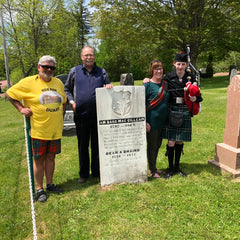 |
 |
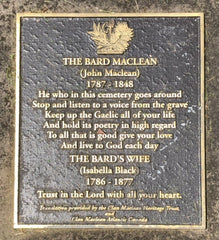 |
| The Welcome Party | Oakley Maclean preparing to play | The Bard Maclean |
This scene was repeated at the many stops along the route of the Ride for Duart (RFD). Duart? The name of the castle where the clan chief of the Macleans, Sir Lachlan, as he is affectionately known, lives and maintains the home of his international family. In case you’re wondering, Duart is an Anglicized spelling of the Gaelic for black point, Dhubhairt. And since we're on the topic of names, whether you're a "Mc" or a "Mac", big "L" or a little "l" you likely descended from the surname "Mhic Ghille Eoin" (Gaelic), from which all variations on the name were derived, or so I'm told ;)

Duart Castle on the Isle of Mull
The castle is undergoing major repairs, the damage a result of the environment it lives in and previous failed attempts to restore it using modern (not traditional) masonry methods. The restoration is in its final stages, but there is still important work to be done and that work comes with a hefty price-tag. You can learn more about Duart and the restoration at http://www.maclean.org/duart-appeal/
My involvement with the RFD began when I sold Ian MacLean of Tidnish Crossroads, NS a used indoor trainer. We met in the Fall of 2018 at the default location (Tim Horton’s) where Ian told me of his plan. At first, as always, you wonder if the person planning the ride is aware of how wind, heat, thirst, hunger, rain and exhaustion can demolish the ill-prepared touring cyclist. But Ian had already been training, had a clear sense of time, effort and distances and possessed the most important trait, a sense of humour. He was hoping I could help him prepare for the ride and plan the route and events in Pictou county. I saw an opportunity to ride a little, learn a lot and make a contribution to what I saw as an important historical edifice. But more importantly to support a great person, with a bicycle and a goal. And so began our friendship.
(This is where the selfie that I forget to take of me and Ian goes)
The team consisted of George Maclean, a friend of Ian’s and former colleague of mine who drove the support vehicle. Karen Maclean, communications and social media person, Ian and myself (not a MacLean, although I did achieve honorary status during the ride). I was with the RFD for four days as my life and work allowed.
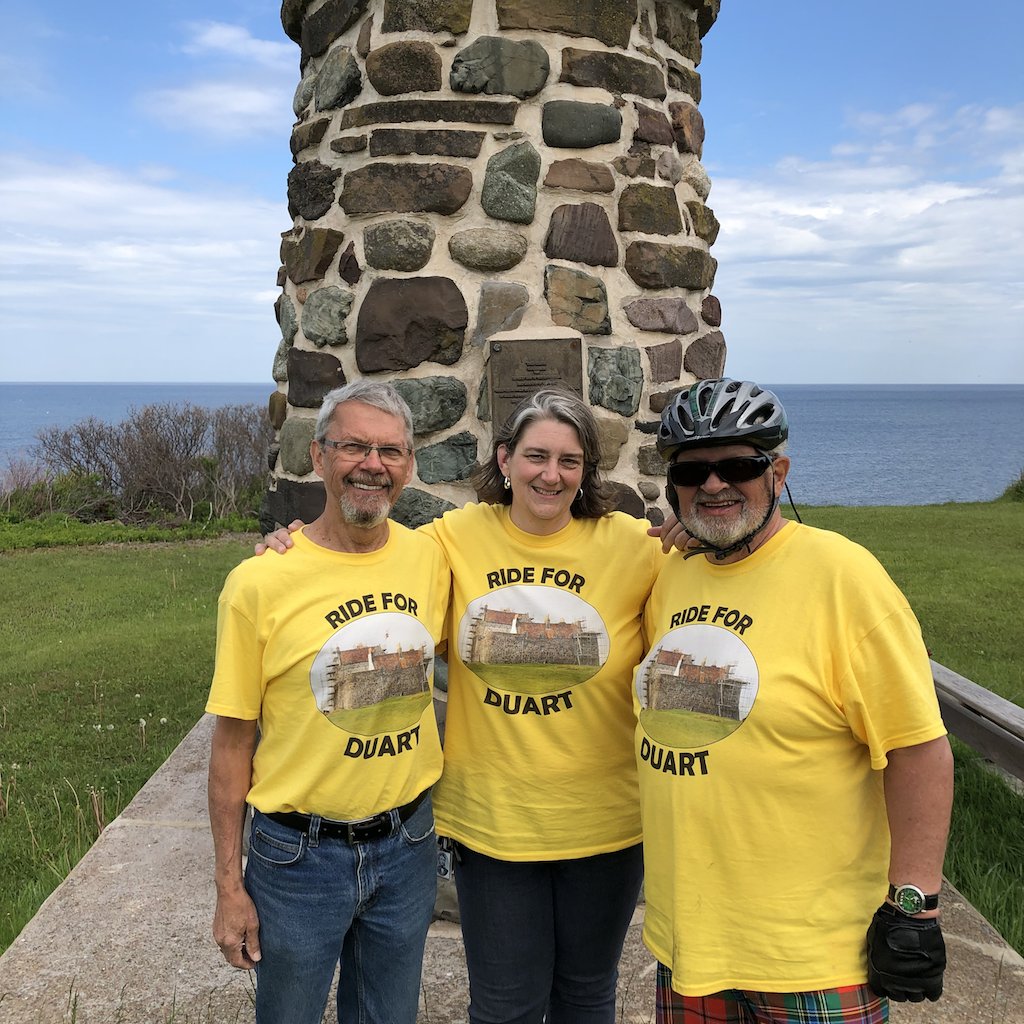
3/4 of the Ride for Duart Team: George Maclean, Karen Mclean & Ian MacLean
I joined Ian first on the Pictou-Merigomish leg of the ride. The day started with a talk on the restoration of Duart at the Ship Hector Heritage Quay followed by a Tartan Ramble. It was Bike Week in Pictou County and a short, themed, bicycle ride along the shores of Pictou harbour served both Masters. Attendance was low on the ride but not without spirit. Kilted and tartan clad riders made stops at Brown’s point, the site of the landing of the Ship Hector in 1773 and the “gut bridge” where an earlier ship, the “Betsy”, arrived bringing the first large contingent of Scottish settlers to Nova Scotia. Ian and a few riders continued on to the Pioneer Log Church in Loch Broom. There they met up with friends Jim and Lynn Maclean and the church curator Marilyn Parker. Places of worship have always been the centre of settlements. For the Scots it was no different.

The Tartan Ramble at Brown's Point (Ship Hector Plaque)
The day’s ride ended in Merigomish along Rte 245. In getting there Ian rode his first long incline and a few shorter, steeper ones. Good bicycle riders are humble, smart and determined. Ian wasn’t doing this to inflate his ego; it was for Duart Castle and he was determined he was going to ride every kilometre. I would hear the rapid shifting of gears to the lowest his 21 speed offered and away he went. Steady, cheerful and upward until the crest of the hill was under his rear wheel.
 |
 |
| Ian on a climb | Bikes have gears; use 'em! |
But Ian’s work wasn’t over. He was scheduled to give another public talk at Àite nan Gàidheal (Place of the Gaels), the home of a Gaelic speaking group that offers Gaelic language lessons and promotes the preservation of the Gaelic language. Our hosts, Wendy McInnis and Debbi Sobey, gave a welcome in Gaelic and provided a wonderful lunch typical of Maritime hospitality. I was reminded of how important the dedication of individuals is to getting things done. The RFD and the Àite nan Gàidheal are great examples of this: individuals working to together helping to save a castle or a language. By the way, if you weren’t there, you missed the best date squares…and there were no leftovers.
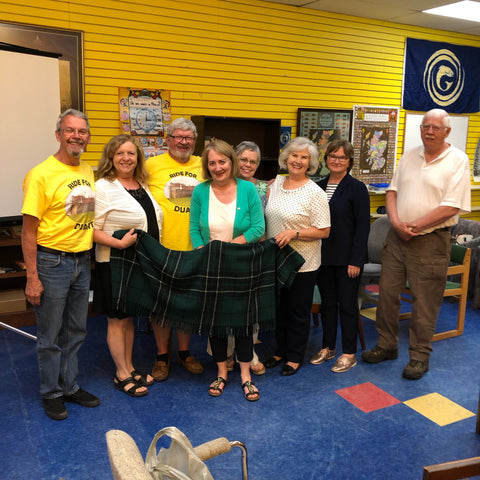 |
 |
| Aite nan Gaidheal (Place of the Gaels) | Ian and Wendy McInnis |
On the morning of day four we road the 19 km from the Merigomish post office to a stretch of road known as the community of Knoydart. The reason for the Knoydart inclusion, was a cairn to commemorate the Battle of Culloden, a seminal event in the history of the Scots and subsequent settlement of Nova Scotia. With the loss of the battle came the loss of the clan system, and many of the cultural and societal elements that defined Scottish life. It was the highland Scots who were most affected. The new laws imposed upon the Highlanders caused many, by choice or by force, to leave Scotland in search of a better life in colonies such Canada and Australia.
The site of the cairn is fitting. On the shore of the Northumberland Strait, the ocean and passage from Scotland sit before you. The connection feels real. Erected in memory of three men who fought at Culloden, one can’t help but to reflect on the life of hardships these men and their families must have faced in fighting for their homeland and then leaving, by choice or by force, to start anew in a foreign land. Nova Scotians are the benefactors of their heroism.
We then turned our bicycles down the Barney’s River Road towards Marshy Hope. It was one of those sparsely populated, forested roads typical of many parts of Nova Scotia. The smell of the forest, the effort of our legs, the warmth of the sun and coolness of the air conspired to give us that perfect feel-good sensation that can only be attributed to cycling. Up and down over the hills and around the corners, Ian and I chatted about small stuff making jokes as we went.
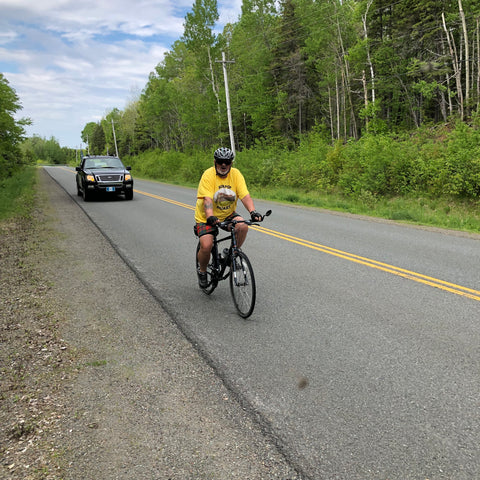 |
 |
|
The miles in-between. Enjoying Nova Scotia's rural secondary roads |
George the Protector (Drive by (Photo) shooting) |
Marshy Hope is a 6 km stretch of road enclosed by mountains (large hills) on both sides. The road is flat and the view gorgeous. Despite being part of the Trans-Canada Rte 105 Highway, it is nice to cycle. At one point we looked back to see George pulling off and coming to a stop. We curiously watched as three people exited their car and mobbed the truck not unlike groupies would the limousine of a rock star. In fact, it happened to be some of Georges biggest fans, his wife Denise and his brother Basil, and his wife Theresa. They were travelling back to Cape Breton from Halifax and it just so happened that our schedules collided! What odds? We exited the 104 to “the old” Rte 4 to Glen Bard, which was to be one of the highlights of the RFD.
Glen Bard is named for a Gaelic Poet, John, (Iain in Gaelic) The Bard Maclean, who settled in Antigonish County in 1819. His life and story is one of great interest to Clan Maclean. Many Macleans in the area trace their roots back to the Bard. His story is one of leaving a relatively comfortable life to follow the promise of a better one in New Scotland only to find hardship and an insatiable longing for his Scotland home typical of new settlers. This is reflected in one of his most recognized poems The Gloomy Forrest.
As we approached the cemetery where the Bard is buried we were met by Fiona Maclean and her grandson Oakley who, dressed in his Maclean kilt, welcomed us with playing Scotland the Brave on the bagpipes! There is something about the pipes that stirs the soul. A better welcome could not have been crafted.
We spent the next hour chatting and discussing the life of the Bard, his ancestors and visiting grave-sites, including that of Rev. A. Maclean Sinclair, Gaelic scholar and grandson of the Bard. More Macleans arrived and the conversations and stories grew. The warmth of the sun and freshness of the air made it a perfect day to be outside milling about, chatting, listening and reflecting. (Yes, there were black-flies, but George’s fly-dope and the celebratory mood made them unnoticeable, sort-of!)
 |
 |
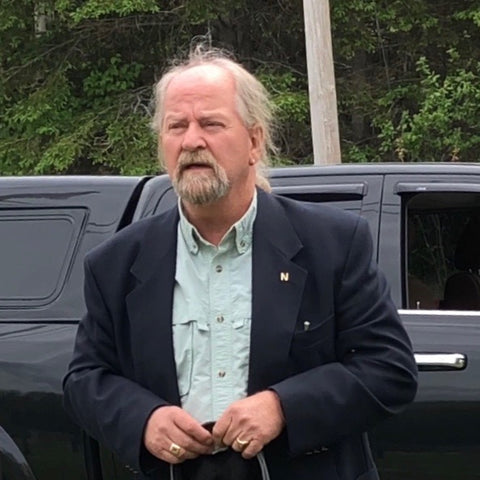 |
| A Gathering at Glen Bard | Guardian of Duart Castle pin |
Peter MacKenzie reciting the Lord's Prayer in Gaelic |
Oakley played several more tunes and Peter MacKenzie “closed” the visit with the Lord’s Prayer spoken in Gaelic. The words were soft and sharp at the same time, and lilted poetically in a way that the Bard himself would have been proud. I think Ian was inspired by the reception at Glen Bard since the remaining 15 km of the ride to Antigonish took what felt like only minutes.
At a turn in the road, just before entering the downtown of Antigonish you will find an assembly of stately cairns erected in honour of several clans. Referred to as Cairn Park, we stop to take some pictures at the cairn for Clan Maclean. The Maclean cairn was built in likeness to the castle on the Clan crest. Included in the construction are rocks and stones from locations significant to clan members. From grave-sites, homesteads and communities, Macleans brought or sent some small piece of Nova Scotia (or elsewhere) to take up residence in this representation and reminder of family and home. The cairn was unveiled and christened shall we say, by the Clan Chief, Sir Lachlan himself in 2009. With a “spark plug” of Toberymory Scotch in hand he gave the thirsty cairn a wee dram and introduced it to the rest of the Clan. Spark plug you ask?; another Maritime colloquial that I’ll leave with you to define.

The Clan Maclean: (R-L) George Maclean, Karen Mclean, Oakely Maclean, Ian MacLean, Fiona Maclean, Carol-Ann Maclean-Mackenzie
 Many of the stops the RFD made were to historical places that recognized the contribution of those that came before us. Cemeteries were common. But one particular cemetery changed the way I see our place in time. Fiona took us to a cemetery in “the Ohio” outside of Antigonish where many of her family’s Maclean ancestors are laid to rest. It was on a hill, accessible only by a steep climb and not noticeable from the road. Nature was trying to reclaim the spot that humans had forgotten. Here rested centuries worth (of the embodiment) of labour, love and knowledge that gave us the world we enjoy today. Yet we easily forget the world we inherited wasn’t always this way. We owe a great deal of gratitude to our ancestors. Cemeteries are not only a place of rest for the departed, but a place of reflection for the living. They keep us humble.
Many of the stops the RFD made were to historical places that recognized the contribution of those that came before us. Cemeteries were common. But one particular cemetery changed the way I see our place in time. Fiona took us to a cemetery in “the Ohio” outside of Antigonish where many of her family’s Maclean ancestors are laid to rest. It was on a hill, accessible only by a steep climb and not noticeable from the road. Nature was trying to reclaim the spot that humans had forgotten. Here rested centuries worth (of the embodiment) of labour, love and knowledge that gave us the world we enjoy today. Yet we easily forget the world we inherited wasn’t always this way. We owe a great deal of gratitude to our ancestors. Cemeteries are not only a place of rest for the departed, but a place of reflection for the living. They keep us humble.
Fiona and Rodney MacLean are in the process of restoring this small but beautiful memorial over looking the Ohio River Valley (in Antigonish county). Before we left Oakley played a tune. I’m sure it was enjoyed by everyone in attendance. More needs to be done to preserve these places. Cemeteries may be where past relations reside, but these places are not removed from the present; they are part of it.
That evening Fiona and Carol-Ann (MacLean-Mackenzie) hosted a Meet and Greet attended by friends, residents of Antigonish and municipal leaders. There was great food, prizes and conversation. Attendees were greeted by Oakley playing his pipes at the entrance. (If you have ever worried about the future of today’s youth, I can assure you that if young Oakley at only 14 years old is any indication, we’re in good hands. Rather than compete in a piping competition, he chose to spend the weekend with his Grandmother piping for her event. Heartwarming!)
It was a very well attended and relaxing event, Ian got to meet many supporters and chat about his cause and love of Duart Castle and what it stands for. I very much liked how Ian described the castle: not an estate or luxurious abode but “What a Highland Castle should be”.
The kindness and generosity of Fiona and Rodney MacLean and of Larry Mclean at the Maritime Inn, Antigonish, was typical of the kindness the RFD received at every stop. Fiona even laundered our heavily worn RFD T-shirts and has a magic spell for getting bicycle chain grease out of t-shirts. Don’t ask for it - it’s a spell - it’s secret :)
 |
 |
| Meet 'n Greet at Maritime Inn, Antigonish, NS | Municipal leaders of Antigonish Town & County presenting a donation to the Restoration of Duart Castle |
On Monday, we road the 60 km to Port Hastings along some very scenic secondary roads having only to ride the Trans-Canada Highway for a few unavoidable kms. The secondary roads through Nova Scotia are second to none. Scenic, often tree-lined, low traffic and with more variation in grades, they make the miles melt away leaving only fond memories of the places you travelled.
We met up with a friend of Ian’s, Harry Daemen at Brosha’s Convenience Store in Lower South River. The wonderful ladies at Brosha’s insisted we not pay for the snacks I had amassed on the counter, and take them instead as their donation to the RFD. If you ever question the goodness in people I suggest you go on an extended bicycle trip. Although this charity was for a cause, it is commonplace to receive the same kindness from complete strangers, just because, while touring by bicycle. Harry rode and chatted with us for a while and safely saw us exit the Trans-Canada. Bicycles bring people together and this was just another example.
The day was warm but not unbearable. Yet the burn on our skin was a reminder that temperature and UV index are not the same. Sunscreen can only do so much; covering up is better. Staying hydrated and happy is the key to enjoyable cycling experiences. You can’t wish the road was shorter or flatter than it is. As has been said a bazillion times, it’s the journey, not the destination. If you cannot find joy in the journey, then you need to learn how to live in the moment more. Ok, I’m done. As my daughter would tell me, “no more hippie-dippie advice, Dad”.
The journey took us to a place where our hydration and happiness was to be tested: The East Harve-Boucher Hill! A three km climb to reach the descent into Aulds Cove. It was a challenging climb. It took us about 30 minutes of non-stop pedalling in low gear to reach the summit. On the hill there was no question of Ian’s determination to complete the challenge he assigned himself. I knew it was the sponsors and donors that he held himself accountable, to finish every pedal-stroke of the 400 km RFD. This three km was no different.

The Harve Boucher Hill. We never tell Ian of the climbs until after we reach to top !!!
Then, as with all challenges, it was over. We reached the summit and began our descent. In some ways it is like it never happened (Ian may disagree). You don’t remember the effort or the hardship, you only feel the elation. This could not have been more evident than on Ian’s face when we stopped in Aulds Cove for lunch. You could feel his sense of pride. To pedal a bicycle up a three-km hill at 73 without stopping is a statement of health, determination and spirit. For Ian it was also knowing he was even closer to his goal and Duart will soon be a little closer to completion.
So at the end of what was to be the hardest climb of the tour, we sat at Tim Horton’s, drank tea and celebrated a little. Then, as happened on several occasions, a lady came through the door and said, “I seen the [signs on the] truck and wanted to make a donation”. It happened to be the sister of Carol-Ann, from Antigonish. She passed George some cash and then went back to her car to get some more! She was excited to see us and we chatted as if we had met before. But that is exactly what, bicycles, causes and connections do. They make friends of people who until then have never met. Or maybe we have met? We all share to some degree, common experiences, values and dreams. Another for Duart!
Part II of the RFD is forthcoming. You can still support the RFD by donating to the Restoration of Duart Castle through the Clan Maclean Atlantic Website at: http://www.clanmacleanatlantic.org/ride/index.html. Oh, and I am not a historian, I tried to learn as much as I could along the way and represent the people and events as accurately as possible. If you have comments or corrections, please send me an email, and I will resolve them.
All the best, Daryl

